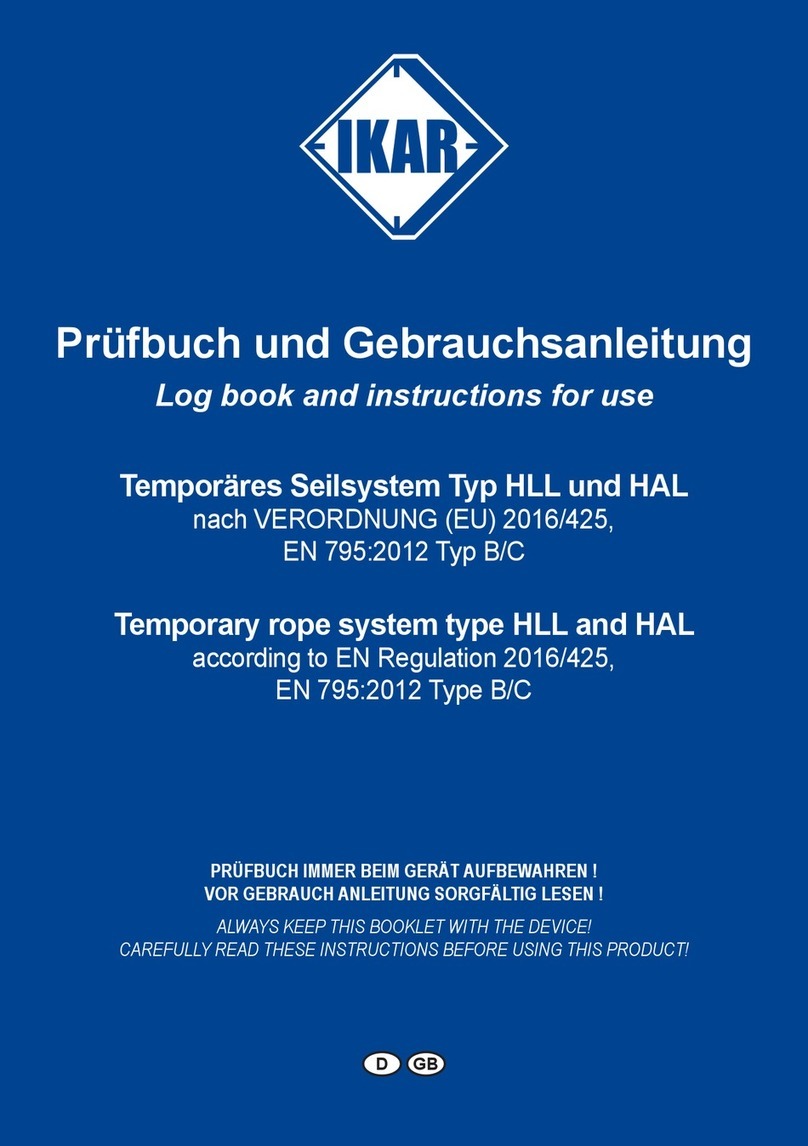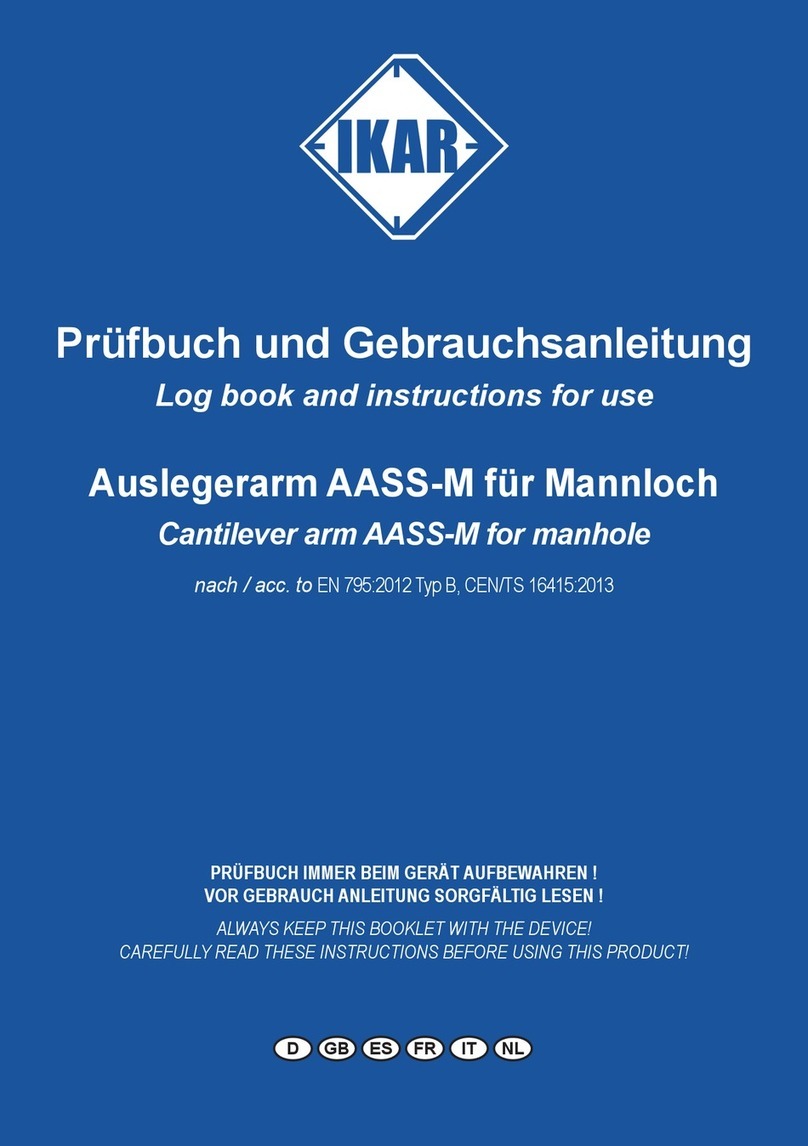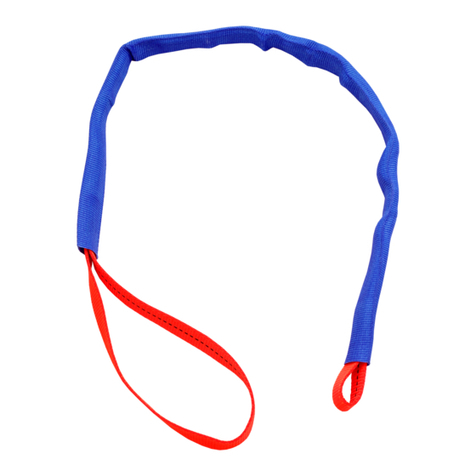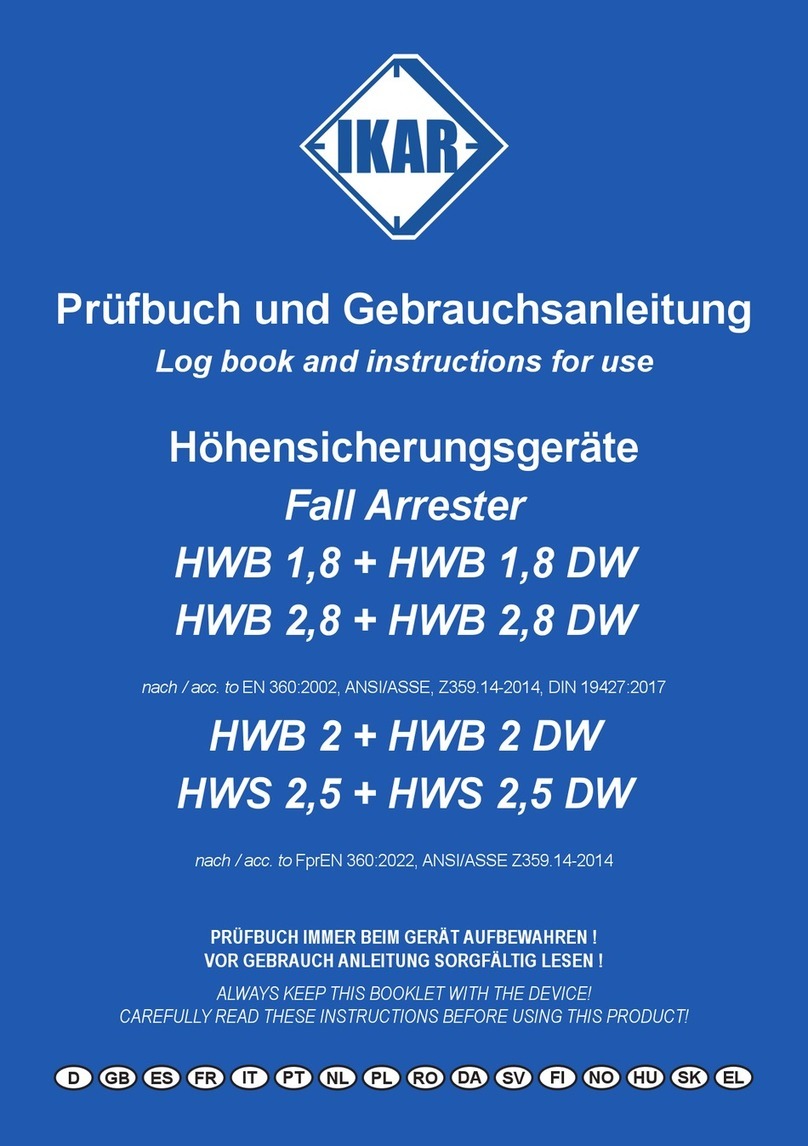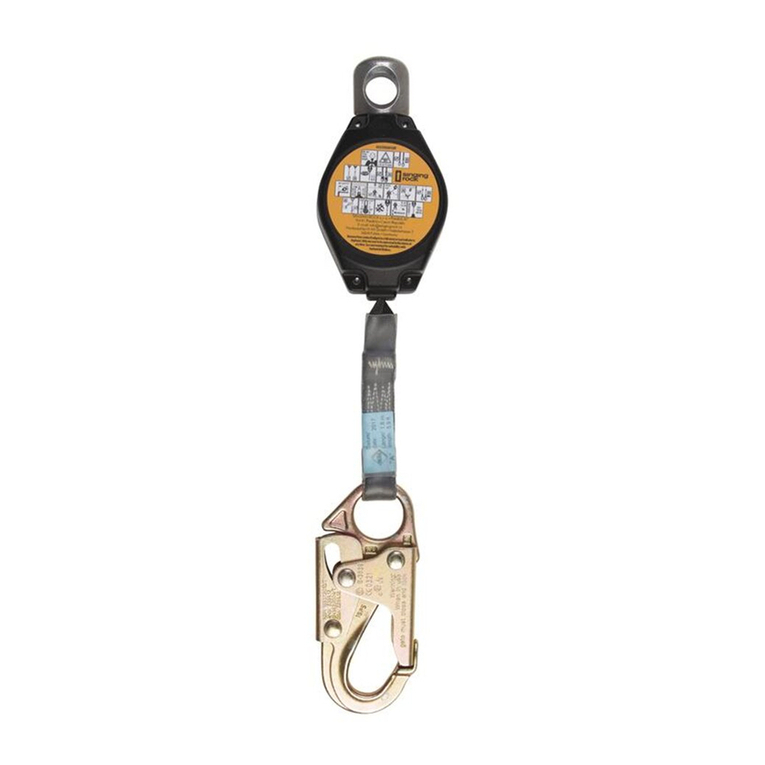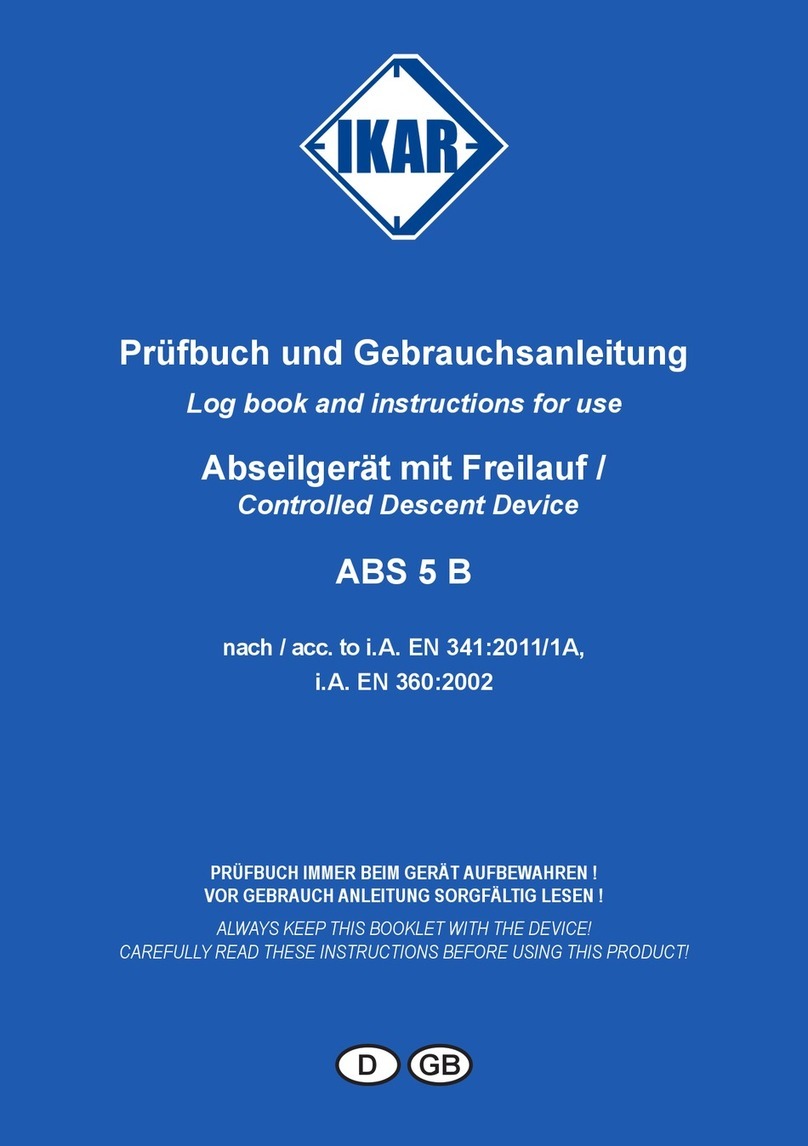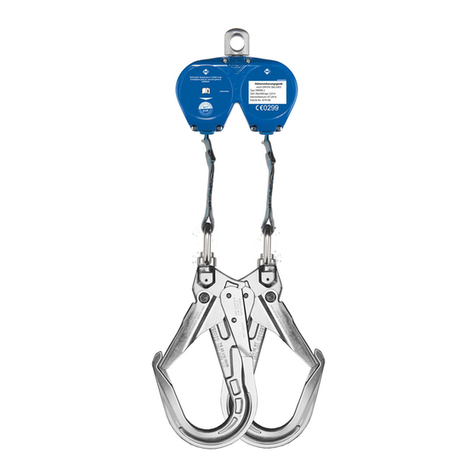
9
1
2
Gebrauchsanleitung
Sicherheitshinweise
1. Höhensicherungsgeräte nach EN 360:2002, CSA Z259.2.2-98, ANSI/ASSE Z359.1-2007, Z359.14-2014 sind
eine Persönliche Schutzausrüstung gegen Absturz (PSAgA). In Verbindung mit einem Auffanggurt nach EN
361:2002, CSA Z259.10-06, ANSI/SSE Z359.1-2007 dient dieses System der Sicherheit von Personen bei
Arbeiten in der Höhe, bei denen die Gefahr eines Absturzes besteht. (z.B. auf Dächern, Gerüsten, Leitern
und Schächten). Das Gerät ist nur bestimmungsgemäß zu verwenden.
2. Bei Nichtbeachtung der Gebrauchsanleitung und der Sicherheitshinweise besteht Lebensgefahr ( 2). Die
Gebrauchsanleitungen aller Bestandteile eines Abstruzschutzsystems sind mit zu beachten.
Im Falle eines Sturzes ist ein Hängen der Person länger als 15 Minuten auszuschließen (Schockgefahr).
3. Zur Benutzung der Höhensicherungsgeräte sind nur Auffanggurte nach EN 361:2002, CSA Z259.10-06,
ANSI/SSE Z359.1-2007 zugelassen (andere Gurte sind nicht erlaubt) ( 1).
4. Ein Gerät kann im Einsatz nur eine Person schützen, kann jedoch nacheinander von mehreren Personen
genutzt werden. Ein Rettungsplan, in dem alle bei der Arbeit möglichen Rettungsfälle berücksichtigt sind,
muss vorhanden sein.
5. Für das Gerät ist ein ausreichend tragfähiger, geeigneter und den nationalen Vorschriften entsprechender
Befestigungspunkt mit einer min. Tragfähigkeit von 9kN (North America 22.2kN) zu wählen. Die Befestigung
erfolgt mittels Karabinerhaken nach EN362:2004 / CSAZ259.12-01 / ANSI/ASSE Z359.12-2009 oder
Anschlagmittel nach EN 795, wobei das Anschlagmittel durch den Bügel des Gerätes gezogen und
mit einem gesicherten Karabinerhaken geschlossen wird ( 3). Bei Geräten mit Drehwirbelaufhängung
wird der Karabinerhaken mit dem Anschlagpunkt und dem Drehwirbel verbunden. Bei Verwendung
des Höhensicherungsgerätes an einer Anschlageinrichtung Typ C / Klasse C nach EN 795 / (nur, wenn
für gemeinsame Verwendung zugelassen) mit vertikal beweglicher Führung ist bei der Ermittlung der
notwendigen lichten Höhe unterhalb des Benutzers auch die Auslenkung der Anschlageinrichtung zu
berücksichtigen. Hierzu sind Angaben in der Gebrauchsanleitung der Anschlageinrichtung zu beachten.
6. Das Gerät sollte möglichst lotrecht über dem Kopf der zu sichernden Person positioniert werden, um beim
Fallen ein Pendeln auszuschließen. Die Aufhängung des Gerätes muss ein Anpassen an eventuelle Seil-/
Bandabweichungen gewährleisten. Nach der Befestigung des Gerätes an dem Anschlagpunkt ist das Ende
des ausziehbaren Verbindungsmittels (Karabinerhaken) an der Auffangöse des Auffanggurtes zu befestigen.
Bei nicht selbstverriegelnden Verbindungselementen (Karabinerhaken) sind diese mittels der Überwurfmutter
zu verschrauben ( 4).
7. Nach Befestigung des Höhensicherungsgerätes an einem geeigneten Anschlagpunkt (nach EN795 /
DGUV R 112-198 / ANSI/ASSE Z359.1-2007) und der Verbindung des Verbindungselementes
(Karabinerhaken) mit der Auffangöse des angelegten Auffanggurtes (nach EN361:2002 / CSA Z259.10 /
ANSI / ASSE Z359.1-2007) ist der Sicherheitsschutz für die Arbeitsperson hergestellt.
8. Vor jeder Benutzung ist eine Sichtkontrolle des Gerätes durchzuführen, sowie die Lesbarkeit der
Produktkennzeichnung zu kontrollieren.
9. Vor jeder Benutzung ist außerdem eine Funktionsprobe durchzuführen. Durch ruckartiges Herausziehen
des Seils/Bandes oder durch eine Gewichtsprobe von mindestens 15 kg. In beiden Fällen muss die
Trommelbremse einfallen ( 5).
10. Über Schüttgut o.ä. Stoffen, in denen man Versinken kann, dürfen Höhensicherungsgeräte nicht zur
Sicherung von Personen eingesetzt werden ( 6).
11. Ein beschädigtes und/oder durch Sturz beanspruchtes Gerät (Fallanzeiger ausgelöst! ( 6a + 6b + 6c )
sowie bei Zweifeln über den sicheren Zustand des Gerätes, ist dieses sofort dem Gebrauch zu entziehen.
Es darf erst nach Überprüfung und schriftlicher Freigabe durch eine sachkundige Person oder den Hersteller
weiter verwendet werden.
12. Je nach Beanspruchung, mindestens jedoch alle zwölf Monate müssen Höhensicherungsgeräte vom
Hersteller oder vom Hersteller geschulten und autorisierten Personen überprüfen werden. Dies muss im
mitgelieferten Prüfbuch dokumentiert werden. Die Wirksamkeit und Haltbarkeit des Höhensicherungsgerätes
hängt von der regelmäßigen Prüfung ab.
13. Bei Brüchen des Garnes, Knicken oder Aufrauungen des Seils/Bandes ist das Höhensicherungsgerät in die
Revisionswerkstatt zu geben. Das Seil/Band muss dort ausgetauscht werden. ( 7).
14. Die DGUV R 112-198 (Benutzung von persönlichen Schutzausrüstungen gegen Absturz) und
DGUV R 112-199 (Retten aus Höhen und Tiefen mit persönlichen Schutzausrüstungen) sowie die
DGUV Information 212-870 (Haltegurte und Verbindungsmittel für Haltegurte) sind zu beachten.
15. Der lichte Abstand unter den Füßen des Anwenders muss mindestens 2,0 m betragen,
wenn das Gerät oberhalb des Benutzers angeschlagen wird.
DEUTSCH
3
4
5
6
6a
6b
7
6c
